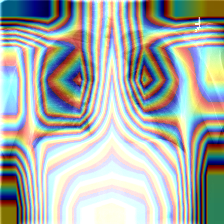i am trying to generate a heatmap for x-ray image but i don’t know how to get weights of pooling layer of the trained model
i tried some images but the output image looks like a corrupted image.
this is the code…
class HeatmapGenerator ():
#---- Initialize heatmap generator
#---- pathModel - path to the trained densenet model
#---- nnArchitecture - architecture name DENSE-NET121, DENSE-NET169, DENSE-NET201
#---- nnClassCount - class count, 14 for chxray-14
model = DenseNet()
def __init__ (self, pathModel, nnArchitecture, nnClassCount, transCrop):
#---- Initialize the network
if nnArchitecture == 'DENSE-NET-121': model = densenet121(False).cuda()
elif nnArchitecture == 'DENSE-NET-169': model = densenet169(False).cuda()
elif nnArchitecture == 'DENSE-NET-201': model = densenet201(False).cuda()
model = torch.nn.DataParallel(model).cuda()
modelCheckpoint = torch.load(pathModel)
model.load_state_dict(modelCheckpoint['best_model_wts'], strict=False)
self.model = model.module.features
self.model.eval()
#---- Initialize the weights
self.weights = list(self.model.parameters())[-2]
#---- Initialize the image transform - resize + normalize
normalize = transforms.Normalize([0.485, 0.456, 0.406], [0.229, 0.224, 0.225])
transformList = []
transformList.append(transforms.Resize(transCrop))
transformList.append(transforms.ToTensor())
transformList.append(normalize)
self.transformSequence = transforms.Compose(transformList)
#--------------------------------------------------------------------------------
def generate (self, pathImageFile, pathOutputFile, transCrop):
#---- Load image, transform, convert
imageData = Image.open(pathImageFile).convert('RGB')
imageData = self.transformSequence(imageData)
imageData = imageData.unsqueeze_(0)
input = torch.autograd.Variable(imageData)
self.model.cuda()
output = self.model(input.cuda())
#---- Generate heatmap
heatmap = None
for i in range (0, len(self.weights)):
map = output[0,i,:,:]
if i == 0: heatmap = self.weights[i] * map
else: heatmap += self.weights[i] * map
#---- Blend original and heatmap
npHeatmap = heatmap.cpu().data.numpy()
imgOriginal = cv2.imread(pathImageFile, 1)
imgOriginal = cv2.resize(imgOriginal, (transCrop, transCrop))
cam = npHeatmap / np.max(npHeatmap)
cam = cv2.resize(cam, (transCrop, transCrop))
heatmap = cv2.applyColorMap(np.uint8(255*cam), cv2.COLORMAP_JET)
img = heatmap * 0.5 + imgOriginal
cv2.imwrite(pathOutputFile, img)
the bad images:
